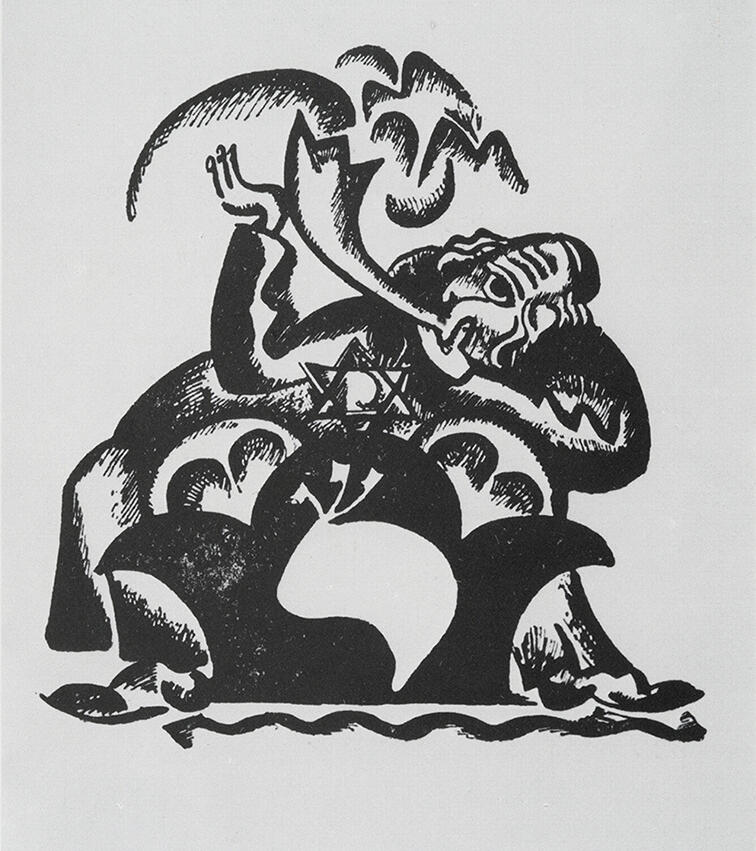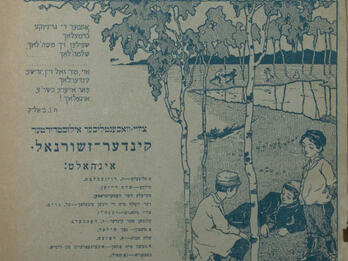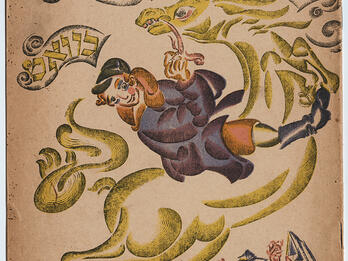Shloyme ha-melekh (King Solomon)
El Lissitzky
1917
Image

Engage with this Source
Creator Bio
El Lissitzky
1890–1941
El Lissitzky, born Lazar Markovitch Lissitzky in Pochinok, Russia, was perhaps the most brilliant expositor of cubo-futurism and then Soviet constructivism. Between 1915 and 1919, he was an active participant in efforts to develop a new Jewish art in Russia. As a youth, Lissitzky studied drawing with the Russian Jewish painter Yehudah Pen in Vitebsk, pursued architectural engineering in Darmstadt, and traveled extensively in Europe, visiting galleries and sketching buildings and landscapes. During the summers of 1915 and 1916, he participated in the Jewish Historical and Ethnographic Society’s expeditions and was inspired by the extraordinary synagogue frescoes he encountered. Between 1917 and 1919, he drew close to other figures seeking to spark a “Jewish cultural renaissance.” He participated in the first exhibition of Jewish artists in Moscow in 1917, worked with Moyshe Broderzon to create what he called “the new Jewish book,” and supplied illustrations for numerous Yiddish, Hebrew, and Russian Jewish publications, particularly books and journals for children. Beginning in 1919, Lissitzky began to relinquish the idea of creating a Jewish national style and played a central role in developing the nonrepresentational and revolutionary constructivist and suprematist styles. After some years in Berlin, he returned to the Soviet Union. In the 1920s and 1930s, he was an important presence in the world of Soviet art as a painter, graphic designer, architect, pavilion designer, typographer, and photographer.
You may also like

Grininke beymelekh (cover)
Grininke beymelekh (Little Green Trees), no. 1 (Vilna: B. A. Kletzkin, 1914.) The title of this Yiddish children’s journal, the first of the genre to appear regularly, was drawn from the Yiddish poem…
Filke
Berl had no father. His mother was very poor and had to go to strangers to make money for bread. Berl used to stay at home alone, and waited for hours for his mother. He had no sisters or brothers, so…
The Fountain of Judah (Three Stories)
Hillel the Babylonian, the important teacher of Israel, was poor and needy, and his daily income consisted of half a zuz. One half of this he used for food, the other half he…
Advertisement for Shtilim, a Hebrew Children’s Journal
We have come together these days, during the awakening of our Hebrew literary sphere, to establish a special newspaper for Jewish youngsters and children.Do we really need to talk at length about how…

Yingl-tsingl-khvat
I have a story here to tell
To all my children—you as well.
Hush, dear friends, be very still—
Hear my story, if you will.
There’s a land that’s quite remote,
Beyond the reach of train or boat;
Even…

The Wanderings of the Little Blue Butterfly in Fairyland
Illustration from the children’s book The Wanderings of the Little Blue Butterfly in Fairyland, first published in Budapest, Hungary, in 1912.


